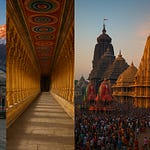Ujjain, nestled along the banks of the holy Shipra River in Madhya Pradesh, is among Hinduism’s most sacred cities. While it is most renowned for Mahakaleshwar Jyotirlinga, one of the twelve Jyotirlingas of Lord Shiva, the city is also home to a unique pilgrimage: the 84 Mahadev Temples Yatra. This rare circuit is believed to represent 84 divine manifestations of Lord Shiva, and completing the yatra is said to free devotees from the endless cycle of rebirth and grant them moksha.
The Legend Behind the 84 Temples
According to the Skanda Purana, a powerful demon named Andhakasur (or Dushan) terrorized the three worlds. Each drop of his blood that fell to the earth created a new demon. To stop this, Lord Shiva struck the demon in Ujjain, and 84 drops of blood fell on the sacred land. At each spot, Shiva manifested himself as a linga to contain the evil. These manifestations became the 84 Mahadev Temples.
Thus, the pilgrimage represents liberation from the 84 lakh yonis (births) and symbolizes the cosmic cycles of creation and dissolution.
Location & Geography
The temples are spread across Ujjain city and its outskirts, forming a mystical circuit.
Many scholars believe they are arranged in a cosmic triangular pattern, linked to ancient astronomy and energy fields.
The pilgrimage traditionally begins at Mahakaleshwar Jyotirlinga and follows a path covering all 84 shrines.
Rituals & Puja Practices
The Yatra (Pilgrimage) – Devotees walk or travel to all 84 temples, offering water, milk, flowers, and bilva leaves.
Mantras – The chanting of “ॐ नमः शिवाय” is constant during the journey.
Special Days – The yatra is especially performed during Shravan Maas (July–August) and Bhadrapada (August–September).
Unique Traditions –
At Nagchandreshwar Temple, the sanctum is opened only once a year on Nag Panchami.
Some temples have specific connections to sages (like Markandeshwar for Rishi Markandeya).
Many shrines are linked with Shakti Peethas, emphasizing Ujjain’s role as a center of both Shaivism and Shaktism.
🛕 The 84 Mahadev Temples – Complete List
Here are the temples as recorded in scriptures and displayed on the board you shared:
Augustyeshwar
Guheshwar
Dhundheshwar
Damrukeshwar
Anadikalpeshwar
Swarnajaleshwar
Trivishtapeshwar
Kapaleshwar
Swargadwareshwar
Karkotakeshwar
Siddheshwar
Lokpaleshwar
Manokamaneshwar
Kutumbeshwar
Indradyumneshwar
Ishaneshwar
Apsareshwar
Kalakaleshwar
Nagchandreshwar
Pratihareshwar
Kukuteshwar
Karkateshwar
Meghnadeshwar
Mahalayeshwar
Mukteshwar
Someshwar
Anarkeshwar
Jateshwar
Rameshwar
Chyavaneshwar
Khandeshwar
Pattaneshwar
Anandeshwar
Kanthadeshwar
Indreshwar
Markandeshwar
Shiveshwar
Kusumeshwar
Akrureshwar
Kundeshwar
Lumpeshwar
Gangeshwar
Angareshwar
Uttareshwar
Trilochaneshwar
Veereshwar
Nupureshwar
Abhayeshwar
Prithukeshwar
Stavreshwar
Shuleshwar
Omkareshwar
Vishweshwar
Neelkantheshwar
Singheshwar
Revanteshwar
Ghanteshwar
Prayageshwar
Siddheshwar
Matangeshwar
Sobhagyeshwar
Rupeshwar
Dhanuhsahastreshwar
Pashupateshwar
Brahmeshwar
Jalpeshwar
Kedareshwar
Pishachmukteshwar
Sangameshwar
Durdhareshwar
Prayageshwar
Chandradityeshwar
Karbheshwar
Rajasthaleshwar
Badleshwar
Aruneshwar
Pushpdanteshwar
Avimukteshwar
Hanumanteshwar
Swapneshwar
Pingleshwar
Kayavarohaneshwar
Bilveshwar
Durdureshwar
84 Mahadev Yatra: clustered route you can do in 2 -3 days
Ujjain’s 84 Mahadev temples are spread across the old city core and the belts along the Shipra. The most efficient way is to cover them in walkable city clusters and periphery loops using auto-rickshaws in between. Start at Mahakaleshwar (central anchor) and move clockwise.
Day 1 - Old City Core (walk + short e-rickshaws)
Theme: Dense pack of shrines around Mahakaleshwar, Harsiddhi, Ram Ghat lanes
Time: ~6–8 hours with darshan/puja halts
Mahakal–Harsiddhi–Ram Ghat circuit (walkable)
Start pre-dawn at Mahakaleshwar for Bhasma Aarti (if you have the pass).
Walk to Harsiddhi and then descend toward Ram Ghat lanes.
In this maze, you’ll encounter a series of Shiva shrines from your list (e.g., Kapaleshwar, Lokpaleshwar, Manokamaneshwar, Siddheshwar, Shuleshwar, Omkareshwar, Vishweshwar, Matangeshwar, Ghanteshwar, Anandeshwar, etc.).
Tip: keep your checklist handy and tick as you go; local pandas (priests) will point the next few in sequence.
Siddhavat–Mangalnidhi pocket (short hop)
Move north along the riverbank by e-rickshaw: you’ll get pockets with older Shiva lingas in small courtyards and akharas.
Puja tips today
Carry bilva (bel) leaves, fresh flowers, raw milk/water, sandal, akshat (rice), dhup.
Chant “Om Namah Shivaya” or Maha-Mrityunjaya softly at each stop.
Dakshina is customary; many shrines are community-maintained.
Day 2 - Northern Arc & West Belt (auto-rickshaw loops)
Theme: Temples towards Mangalnath / Kal Bhairav / Sandipani axes
Time: ~7–8 hours
Mangalnath–Bhairavgarh loop
Head to Mangalnath area (Shiva’s “birthplace of Mars” in tradition).
Cover nearby Mahadev shrines (many from your list fall here under names like Uttareshwar, Trilochaneshwar, Veereshwar, Abhayeshwar, Prithukeshwar, etc., often set in small enclosures off the main road).
Then to Kal Bhairav belt (Bhairav temples are guardians of Ujjain; you’ll find adjacent/nearby Mahadev shrines).
Sandipani Ashram–Gomti Kund pocket (north-east)
Around Sandipani, you’ll find quiet shaiva shrines (Akrureshwar, Kundeshwar, Pattaneshwar types).
Ask at the ashram gate for the nearest 84-Mahadev markers; many are in contiguous gullies.
Puja tips today
For Nagchandreshwar (one of the list’s special ones), the garbhagriha opens only on Nag Panchami; on normal days, do darshan from outside and note on checklist.
Day 3 — Southern/Eastern Arc (Indore Rd / Kshipra East) - optional or half-day
Theme: Gadkalika–Triveni–Nanakheda side
Time: 4–6 hours (or finish Day 2 if you’re quick)
Gadkalika–Triveni belt
Take an auto to Gadkalika (Shakti peeth area) then run the Triveni side on Kshipra’s eastern bank.
Here you’ll tick off the remaining outliers (e.g., Pashupateshwar, Kedareshwar, Sangameshwar, Durdhareshwar, etc.).
Wrap up back toward the old city to complete any you missed.
Significance of Completing the Yatra
Considered equal to visiting all twelve Jyotirlingas.
Grants freedom from the cycle of birth and death.
Strengthens spiritual discipline through tapasya, bhakti, and seva.
Ujjain becomes not just a city, but a living mandala of Shiva’s energy.
How to navigate on the ground (works really well)
Use your checklist CSV on phone/print; mark the cluster/area as you discover each temple.
At cluster starts (Mahakal, Mangalnath, Kal Bhairav, Sandipani, Gadkalika) ask the local pujari: “84 Mahadev waale kaunsa-kaunsa yahan paas mein milenge?” They’ll give an ordered micro-route of 8–15 in that pocket.
Auto-rickshaw hack: say “84 Mahadev darshan karna hai - Mangalnath–Bhairavgarh side” or whichever arc you’re on. Many drivers know the run.
Daily timing & etiquette
Best window: Brahma-muhurta to late morning; resume 4–9 pm.
Dress modestly; keep offerings minimal to reduce waste.
Photography: ask first; some small shrines prefer no flash.
Hydration: carry water; old-city lanes can be tight, use light footwear.
Simple ritual you can repeat at every shrine (2–4 minutes)
Quietly chant “Om Namah Shivaya” 5–11 times.
Offer bel-patra, flowers, a small abhishek (water/milk if permitted).
Touch threshold, do pradakshina (1 or 3 circumambulations if space allows).
Offer akshat & sandal, receive tilak and prasad.
Note the temple in your checklist and move on.
The 84 Mahadev Yatra of Ujjain is more than a physical pilgrimage - it is a symbolic journey across cosmic time, karma, and liberation. By visiting these 84 shrines, devotees not only honor Lord Shiva’s divine manifestations but also take a step closer to moksha, the eternal union with the Supreme.











